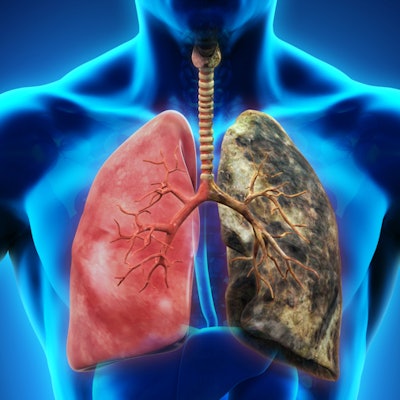
By measuring the percentage of pulmonary fibrosis on CT exams in lung cancer patients, computer-aided detection (CAD) software can also detect and quantify the extent of interstitial lung abnormalities (ILAs) and help in risk stratification of these patients, according to research published online June 4 in Radiology.
After retrospectively applying CAD software to preoperative CT studies of more than 200 patients with lung cancer, a team of Japanese researchers found that CAD measurements of the percentage of fibrosis in the lung were associated with the presence of ILAs -- and patient outcomes.
"Greater computer-aided detection percentage fibrosis extent at preoperative CT independently predicted worse disease-free survival in patients with lung cancer," wrote lead author Dr. Tae Iwasawa, PhD, of Kanagawa Cardiovascular and Respiratory Center in Yokohama, and colleagues.
Although interstitial lung abnormalities are found on CT exams of approximately 10% of subjects receiving lung cancer screening, the relationship between histologic findings of ILAs and patient prognosis isn't known, according to the researchers. As a result, they sought to use CAD software developed by Japanese firm Mebius to evaluate the extent of ILAs as a predictor of disease-free survival in 217 lung cancer patients who had received complete resection of their lung cancer.
Blinded to the patients' clinical information, two radiologists, each with 10 years of experience, scored the percentage fibrosis extent on preoperative chest CT studies and also determined the presence of ILAs and the usual interstitial pneumonia (UIP) pattern -- a known risk factor for acute exacerbation after lung cancer treatment.
In addition, they evaluated the progression of ILAs on follow-up CT studies. Two pathologists also evaluated pathologic specimens for the presence of the UIP pattern. The CAD software measured the percentage of fibrosis extent on the CT exams.
The radiologists found that 47 of the lung cancer patients had interstitial lung abnormalities and 24 had a usual interstitial pneumonia pattern on the CT exams; the pathologists detected a UIP pattern on 25 of the studies. These 47 ILAs were associated with worse disease-free survival (hazard ratio: 3.3, p < 0.001).
After performing regression analysis, the researchers found that the CAD-measured percentage of pulmonary fibrosis on CT was independently associated with the presence of ILAs (odds ratio: 3.1, p < 0.001) and a UIP pattern. In turn, a greater percentage of pulmonary fibrosis measured by CAD was independently associated with worse disease-free survival (hazard ratio: 1.3, p < 0.001).
"We found that determining the percentage fibrosis extent with CAD was useful for evaluating the existence and severity of ILAs at preoperative CT and for risk stratification of patients with lung cancer," the authors wrote.
In an accompanying editorial, Dr. Jin Mo Goo, PhD, of Seoul National University in South Korea, said that the study provides evidence for the clinical importance of ILAs in lung cancer patients.
"Further guidelines for defining and subcategorizing ILAs are necessary for the consistent usage of terminology and for further research investigations," he said.




















